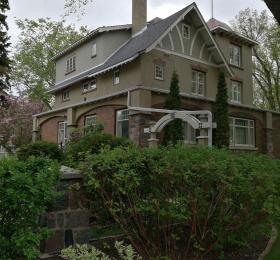Sommerville / Pettit Residence
- Designated
Description of the Historic Place
The Sommerville/Pettit Residence features a two-and-a-half storey, stucco and brick house constructed in 1911 in the neighbourhood of Nutana.
This historic place, located at 870 University Drive, was designated as a Municipal Heritage Property in 1988. The designation applies to the exterior of the house; the wood-frame garage, formerly a carriage house, and a wood gazebo structure. The Sommerville/Pettit Residence was the first privately owned home in Saskatoon to receive Municipal Heritage Designation.
Heritage Value
The heritage value of the Sommerville/Pettit Residence lies in its architectural design, which blends Tudor Revival and Spanish Revival influences. Opulence in form, design and materials is reflected in its tall cross gables and dormers, broad front verandah, a dramatic port-cochère and a bell-cast tower. In keeping with the request of the owner, Herman Petitt, for a house plan that would turn heads, this lavish prairie mansion was designed by prominent architect, Frank P. Martin. The Sommerville/Pettit Residence is an important representation of his domestic design skills during Saskatoon’s pre-World War I building boom. The tall carriage house, constructed in 1912 and a matching 3-sided gazebo built in 1936, complement the design of the house with their wood-frame construction, hip roofs and exposed rafter tails.
The heritage value of the Sommerville/Pettit Residence also resides in its contribution to a neighbourhood of stately homes located near the University of Saskatchewan. A number of high-end homes were built on University Drive when the growth of the University made this road the upper-class residential neighbourhood of its era. The Sommerville/Pettit Residence is strongly associated with the history of Saskatoon, particularly the family of Herman Pettit, an Ontario farmer and real estate developer who lived in Saskatoon briefly, until 1915. It is also associated with the family of George B. Sommerville, a Saskatoon dentist, who owned the house from 1918 to 1936. Nationally-recognized western Canadian historian, Arthur Silver Morton, also occupied the house in the 1920s.
The house was converted to a multi-family dwelling during the late 1920s. Changing economic conditions in the city and proximity to the University resulted in many large homes in this neighbourhood being converted into apartments. In this case, each floor was turned into a separate suite. The suites have since been removed and the house has been returned to a single unit dwelling. The Sommerville/Pettit Residence stands as a representative example of the boom and bust history of Saskatoon.
Through the City’s Heritage Awards Program, the Sommerville/Pettit Residence received an award for the restoration of a private residence in 1989.
Source: City of Saskatoon Bylaw No.7866 / City of Saskatoon Built Heritage Database / Canadian Register of Historic Places
Character Defining Elements
Key elements which contribute to the heritage value of this historic resource include:
- Its Tudor Revival architectural influences, evident in: its steep cross-gabled roofs, stucco cladding, half-timbering, exposed rafter tails, narrow casement windows with simple mullions and muntins, brick lintels and transom panes;
- Its Spanish Revival influences, evident in: its verandah arches, parapet wall and corner tower with bell-cast roof;
- The port-cochère, porthole windows and their placement, and the fieldstone piers of the verandah;
- The massing and height of its carriage house, as well as the roof line and exposed rafter tails of both the carriage house and gazebo;
- The placement of the carriage house and gazebo in relation to the main dwelling; and their wood-frame construction;
- Those elements which speak to its anchor role in the University neighbourhood of upper scale homes, such as its massing, height and scale;
- Its placement on its original lot; and
- The robust materials of its façade that include brick and fieldstone.


